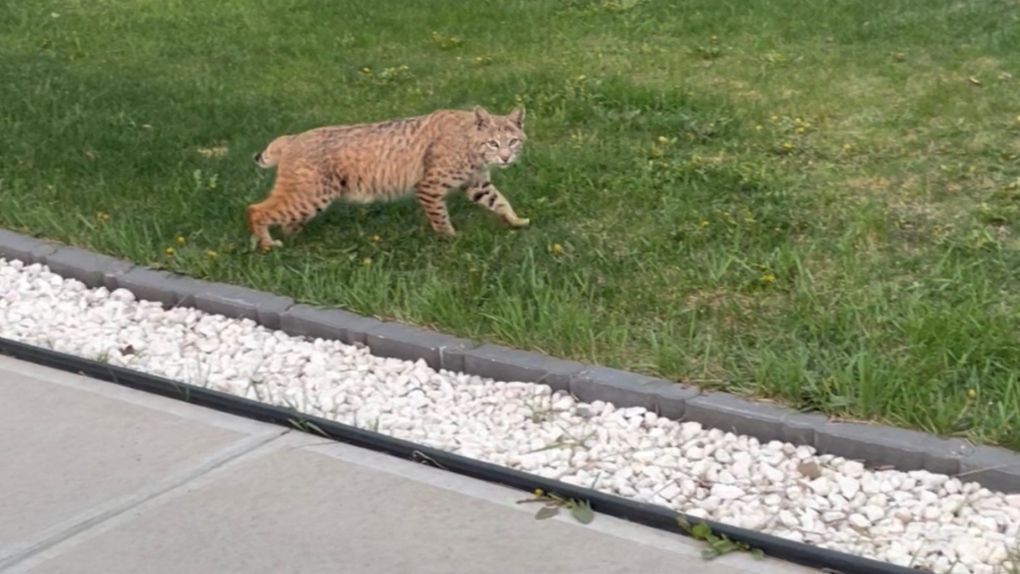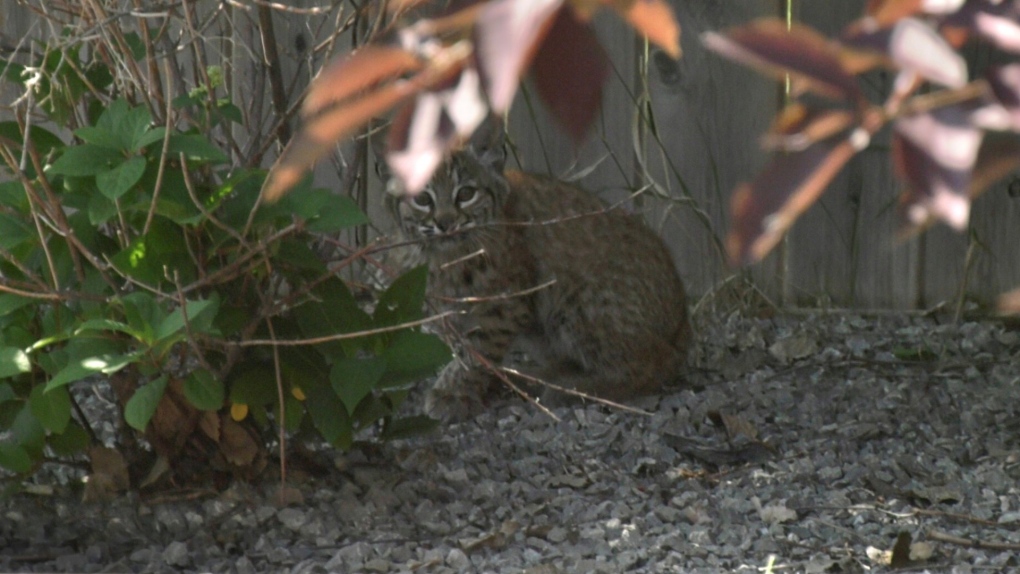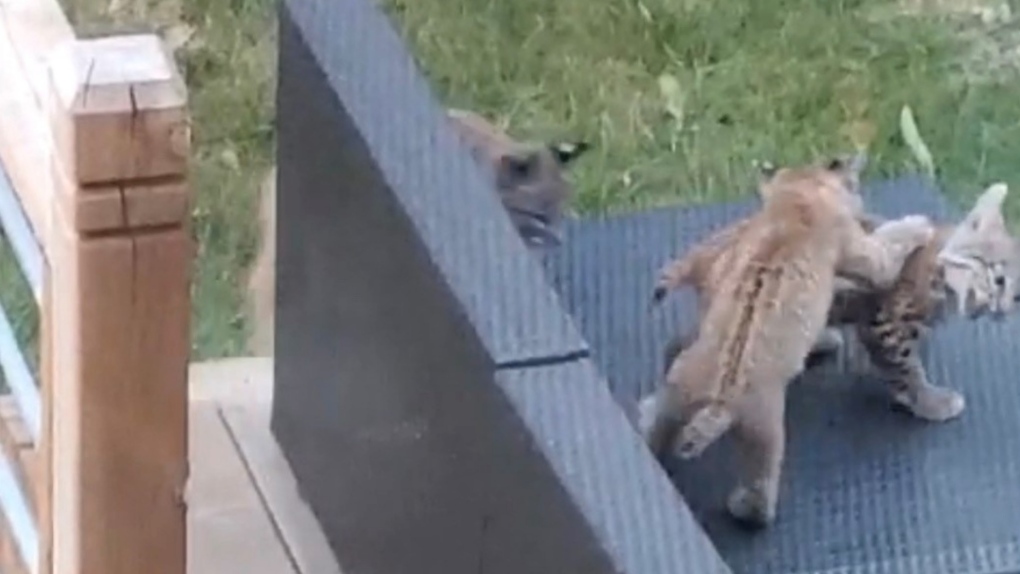'No one will help us': Calgary family calls on wildlife officers for support after four bobcats inhabit their backyard
A northwest Calgary family is calling on authorities for help and expressing concerns for the safety of nearby pets and children after four bobcats moved into their backyard this week.
Isabelle Miller says a mother bobcat with an injured back left leg is regularly seen frequenting her property in Panorama Hills with her three kittens.
The animals were first seen on Tuesday.
Miller says her family first called 311 and non-emergency police services but their requests for help have been pushed aside.
"No authorities of any kind are willing to help us to get rid of them," Miller said.
"Instead, we are being told we will need a damage control licence and to pay professionals out of pocket to handle the situation.
"Why are taxpayers that are reporting dangers being told public services are refusing to help?"
 Isabelle Miller says a mother bobcat with an injured back left leg is regularly seen frequenting her property in Panorama Hills with her three baby cubs.
Isabelle Miller says a mother bobcat with an injured back left leg is regularly seen frequenting her property in Panorama Hills with her three baby cubs.
Miller says Fish and Wildlife also would not send an officer to her home and told her to make her backyard as "uncomfortable as possible" in an effort to control the situation.
"Fish and Wildlife called us to tell us they would not be coming, and that they no longer come out for bobcats. There are too many in the city now, they said. Had it been a coyote, they would have come out, apparently, but they just suggested more things for us to try," Miller said.
She has since purchased an airhorn, sprayed her hose at the bobcats and used mothballs as well as other repellent sprays but nothing has worked.
 Isabelle Miller says a mother bobcat with an injured back left leg is regularly seen frequenting her property in Panorama Hills with her three baby cubs.
Isabelle Miller says a mother bobcat with an injured back left leg is regularly seen frequenting her property in Panorama Hills with her three baby cubs.
Several neighbours have also noticed the bobcats walking along the fences of their backyards, entering their driveways and even coming within a few metres of their children.
Kamal Chaudhry says the bobcats often enter his property and that the mother bobcat can be very defensive.
"It's definitely very concerning," Chaudhry said.
"She gets a little bit more aggressive to protect her (kittens), right? So I am just knocking on the doors of every neighbour just in case, to make them aware of it."
Six-year-old Bishop Anderson-Haze is one of those children often playing with nearby friends.
"I always stay by the house and I always do everything I can to stay safe," he said.
 Isabelle Miller says a mother bobcat with an injured back left leg is regularly seen frequenting her property in Panorama Hills with her three baby cubs.
Isabelle Miller says a mother bobcat with an injured back left leg is regularly seen frequenting her property in Panorama Hills with her three baby cubs.
FISH AND WILDLIFE OFFICERS RESPOND 'AS APPROPRIATE'
In a statement to CTV News, Fish and Wildlife said it works in collaboration with the City of Calgary to monitor wildlife roaming urban spaces.
"The City of Calgary has a wildlife monitoring map to help residents understand where various species of wildlife live and travel within the city and what they can do to prevent conflict with wildlife," the statement read.
"If you encounter wildlife that may be a public safety concern, you are advised to report the incident to the nearest Fish and Wildlife office at 310-0000, or call the 24-hour Report a Poacher line at 1-800-642-3800. This line is monitored and Fish and Wildlife officers will respond as appropriate to wildlife concerns and reports.
"For more information on avoiding conflict with bobcats, visit https://www.alberta.ca/bobcats.aspx."
Fish and Wildlife later provided a second statement:
"Bobcats are increasingly common in Calgary, where they feed mostly on rabbits, hares and other small mammals like mice and squirrels," it read.
"We understand that many people worry about bobcats being dangerous, but these animals do not generally present a danger to the public and are not at all likely to attack humans. Fish and wildlife follows up with individuals who report a bobcat sighting and provides them with tips to help them get rid of the bobcats from their properties by making the environment uncomfortable and unattractive. If a bobcat is returning to a neighbourhood or a property, it is because shelter or easy meals are available there."
In its second statement, Fish and Wildlife again suggested the means of contact from its first statement.
The City of Calgary also responded to requests for comment and said it does not manage wildlife like bobcats on private property.
"Bobcats are the jurisdiction of Fish and Wildlife. Bobcats are generally considered not dangerous and are very good at avoiding conflict with humans. However, bobcats do present a threat to some pets that are left outside unsupervised, especially cats," the city said in an emailed statement.
"The city asks citizens to send bobcat sightings to 311 to assist with planning around land management. For suggestions on how to discourage bobcats from coming to your property or how to encourage them to leave, visit https://www.calgary.ca/council/ward-2/articles/bobcats-in-the-community.html."
'MAKE WILD ANIMALS FEEL AS UNWELCOME AS POSSIBLE': ALBERTA WILDLIFE BIOLOGIST
Erin Miller, a wildlife biologist for the Cochrane District with Alberta Environment and Protected Areas, says homeowners should do what they can to avoid wild animals and make them feel as unwelcome as possible if they approach private properties.
"Generally, what this means is removing food, removing shelter and removing water that may attract them to your property. So some examples of that would be cleaning up garbage into approved bins and securing those lids. So not having bags of garbage around your property," Miller said.
"We'd also recommend cleaning up and removing any potential shelter or hiding areas for these animals. So trim any overgrown shrubs. You can remove low-hanging branches or you can close off any open areas such as under decks or sheds."
Miller says bobcats are generally very wary of people, but do prey on small pets, specifically cats and small dogs, so those pets should be left inside if a bobcat is present.
Motion detector lighting may also be a good deterrent to keep wildlife away from homes.
"Bobcats are called crepuscular, which means they're mostly active at dawn and dusk, so when that motion detector lighting comes on, they feel pretty uncomfortable and they'll generally leave an area," Miller said.
CTVNews.ca Top Stories

Richard Perry, record producer behind 'You're So Vain' and other hits, dies at 82
Richard Perry, a hitmaking record producer with a flair for both standards and contemporary sounds whose many successes included Carly Simon’s 'You’re So Vain,' Rod Stewart’s 'The Great American Songbook' series and a Ringo Starr album featuring all four Beatles, died Tuesday. He was 82.
Hong Kong police issue arrest warrants and bounties for six activists including two Canadians
Hong Kong police on Tuesday announced a fresh round of arrest warrants for six activists based overseas, with bounties set at $1 million Hong Kong dollars for information leading to their arrests.
Read Trudeau's Christmas message
Prime Minister Justin Trudeau issued his Christmas message on Tuesday. Here is his message in full.
Stunning photos show lava erupting from Hawaii's Kilauea volcano
One of the world's most active volcanoes spewed lava into the air for a second straight day on Tuesday.
Indigenous family faced discrimination in North Bay, Ont., when they were kicked off transit bus
Ontario's Human Rights Tribunal has awarded members of an Indigenous family in North Bay $15,000 each after it ruled they were victims of discrimination.
What is flagpoling? A new ban on the practice is starting to take effect
Immigration measures announced as part of Canada's border response to president-elect Donald Trump's 25 per cent tariff threat are starting to be implemented, beginning with a ban on what's known as 'flagpoling.'
Dismiss Trump taunts, expert says after 'churlish' social media posts about Canada
U.S. president-elect Donald Trump and those in his corner continue to send out strong messages about Canada.
Heavy travel day starts with brief grounding of all American Airlines flights
American Airlines briefly grounded flights nationwide Tuesday because of a technical problem just as the Christmas travel season kicked into overdrive and winter weather threatened more potential problems for those planning to fly or drive.
King Charles III is set to focus on healthcare workers in his traditional Christmas message
King Charles III is expected to use his annual Christmas message to highlight health workers, at the end of a year in which both he and the Princess of Wales were diagnosed with cancer.

































